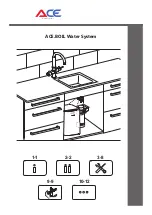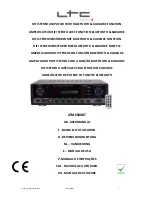
EIB Alarm Central Unit, surface-
mounted
75730010
Technical
Documentation
© Gebr.Berker 2005
Version: 18.08.2005
Page: 48 / 81
(Subject to prior change)
75730010.doc
Part 9
5.3 Fault acknowledgement operations
The alarm central unit knows various causes of faults. Fault messages will be read in the display units in dependence
of the areas concerned.
A fault can have one of the following causes:
Cause of Fault
Message Text in the Display Units
Remark
Missing detector in a safeguarding area.
"[detector text] missing detector"
1)
The sabotage detector of a safeguarding
area has tripped.
"[detector text] sabotage"
1)
The sabotage detector of an arming device
has tripped.
"[detector text] sabotage (AD)"
1)
The sabotage loop of the alarm central unit
has been interrupted or short-circuited.
"Alarm central unit wired detector
sabotage"
1)
3)
The sabotage contact of the alarm central
unit has been opened.
"Alarm central unit enclosure sabo-
tage"
1)
3)
Defective or weak storage battery (battery
voltage < 11.0 V).
"Battery fault"
2)
3)
Overload detection; e. g. short-circuit in a
connected siren.
"Alarm indicator overcurrent"
3)
Mains failure > 30 seconds and
< 60 minutes.
"Mains failure < 60 minutes"
2)
3)
Mains failure > 60 minutes.
"Mains failure < 60 minutes"
3)
Alarm transmission device fault signal.
"ATD failed"
2)
3)
Abortive heartbeat check between two
alarm central units.
"Subordinate alarm centr. unit miss-
ing"
1)*
3)
One or several fire detectors have sig-
nalled a fault.
"Fault in the "fire detector" area"
4)
1) Tripped sabotage detectors will lead to sabotage alarm in armed areas.
*: An abortive heartbeat check can raise sabotage alarm (parameterizable).
2) You will not have to immediately eliminate such causes of faults to keep the alarm central unit running without any
interruptions. In such cases, acknowledging in the display units and resetting (disarming/alarm resetting) will be
sufficient.
Only upon the next disarming of any area armed before, the alarm central unit will again signal an alarm central unit
fault together with the cause of the fault in this area (in the event of a mains voltage fault in all areas). Resetting this
message again (disarming/alarm resetting) will be required to enable you to continue working without any interrup-
tions. In this case, you need not acknowledge or call such fault messages again into the display units.
The faults marked "2)" will remain in the display units until their causes have been eliminated.
In armed areas, such fault messages will not raise any alarm.
Exception: "ATD checkback input fault: You can parameterize the response to an alarm when there is a fault in the
alarm transmission device
(refer to "7. System Monitoring", page 53)
.
Any other causes of faults (not marked "2)") must be eliminated until the faults signals can be reset.
If a battery fault occurs you should replace the battery as soon as possible
(refer to "12.2 Battery replacement",
page 60)
. A battery fault message will remain active until you have replaced the storage battery.
















































